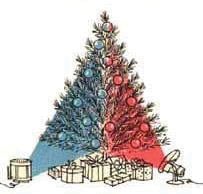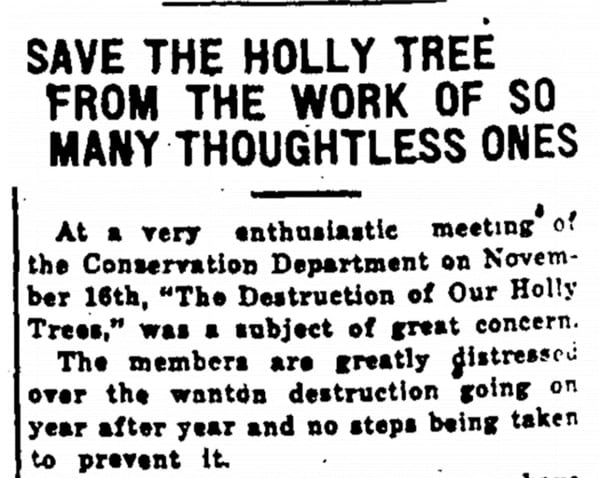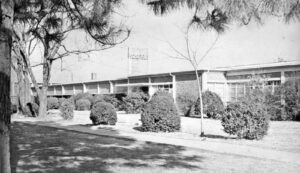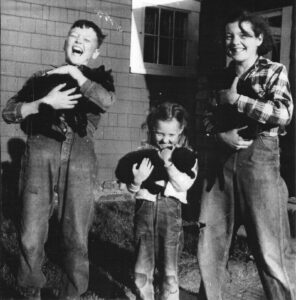Have you ever watched A Charlie Brown Christmas television special and wondered about the metal Christmas tree lot that Charlie Brown visits? Did you know that cutting down a holly tree almost became illegal in our area? Let’s explore this curious affinity for metal Christmas trees and an early effort to save the holly tree in the latest episode of the Cabinet of Curiosities!
The History of Christmas Trees
When imagining our ancestors and how they may have spent Christmases a few hundred years in the past, many of us picture a happy family around a large, decorated tree, with a blazing fire in the hearth and children playing at their feet. The tree was cut from a forest on the edge of the property, and the family has decorated it with handmade ornaments carefully crafted from scraps of fabric and patterned paper. There are real candles on several of the branches, though the wicks won’t be lighted until Christmas Eve.
While this is a beautiful scene, it isn’t technically correct — at least not for a few more decades. The history of Christmas trees isn’t actually a long one. In fact, the life of the artificial Christmas tree is longer than that of the live Christmas tree! The tradition of using evergreens to celebrate the season goes back to Egyptians and Romans, but the use of decorated trees is a touch more modern, originating in Germany in the mid-19th century. The first of these trees was artificial: colored and dyed feathers pasted to a paper cone to create the illusion of a tree that could decorate a tabletop. This soon gave way to the use of small trees or saplings, though the decorated tree would remain on tabletops for several decades to come.
Don’t touch that holly tree!
It was a holiday tradition in Richmond and Aiken County homes to have decorations of mistletoe, smilax, and holly in the early 1900s. The fashion was so popular that merchants and peddlers were going onto private and public lands to chop down entire holly trees and masses of mistletoe. Many Christians at the time associated the spiny leaves of the holly with the crown of thorns and its red berries with the blood of Jesus Christ, and therefore, the branches of the holly tree are associated with Christmas. However, there’s a problem with the popularity of holly trees and their branches being used as decorations. According to the Arbor Day Foundation, holly trees grow slowly with an estimated gain in height of only 12 – 24” each year. Thus, there was more demand for holly boughs and holly trees in our area than nature could provide.
By 1916, there were calls to “Spare the holly!” by forestry workers and landowners alike in the CSRA. In Augusta, Georgia, local chapters of the Woman’s Clubs led the charge in the preservation of regional holly trees. Club members wrote letters to newspapers, encouraged the planting of holly tree saplings, and even called out neighbors who broke the holly-cutting ban. As late as 1930, the effort to stop the cutting of holly motivated one letter writer to the Augusta Chronicle to shame publicly a local school that was displaying a cut holly tree on its campus during Christmas time. With time and advocacy, the mass cutting of holly trees was dampened and many locals found alternative ways to decorate their homes for the holidays.

An illustration that shows how to light and decorate your aluminum Christmas tree, publicized by the Aluminum Corporation of America.
O Tannenbaum, O Tannenbaum, thy leaves are so metallic.
In the early 20th century, artificial Christmas trees, very much like the trees we see today, with twisted metal wire branches inserted into a central pole, were incredibly popular and used by every class of American. A 1937 issue of Popular Mechanics advocated updating these tired old trees by spraying them with aluminum paint using an insect spray gun so they would appear “as if fashioned of molten silver.” By 1955, the Space Age and Atomic Age were upon us, and the times were reflected in our material culture as a society, even down to our Christmas trees!
It was at this time that aluminum trees were first commercially manufactured and retailed for $25. The most popular was silver, though they came in many colors, the rarest being pink. These trees were meant to look futuristic and to capture the glitter of the Space Age. They could not be illuminated in the traditional sense because draping electric lights over the branches of an aluminum tree could cause a short circuit and a fire! Instead, there was an option to buy accessories such as a rotating tree stand or a light with spinning colored discs that would light up the whole tree in red, green, blue, or yellow.
By 1959 the Korean War had ended and metal was much more readily available for commercial use, making these wildly popular trees a household certainty in many homes. That is, right up until the premiere of A Charlie Brown Christmas on television in 1965, which, according to many historians, spelled certain death for the beloved aluminum Christmas tree. In the television special, Lucy urges Charlie to purchase a large pink aluminum tree from a tree lot. Spoiler alert (50 years too late): Charlie chooses a very small and humble real tree and denounces the over-commercialization of Christmas, entreating us all to remember the true meaning of the holiday. The aluminum tree becomes the unwitting villain of the tale, and sales of the tree tanked until production was entirely halted in the 1970s. By that time, over one million aluminum trees had been produced, decorated, and then eventually sold in garage sales.
As always, fashion trends tend to be cyclical and the aluminum tree is once again available for purchase by modern consumers. You can find them easily online if you want to relive your childhood memories. However, be ready to shell out big bucks for original vintage ones. Recently, a rare pink 8-foot aluminum tree sold in an online auction for $3,000. Now what would Charlie Brown think of that?
Stay curious y’all!

Newspaper headline decrying the destruction of holly trees. Augusta Chronicle, November 25, 1917.






